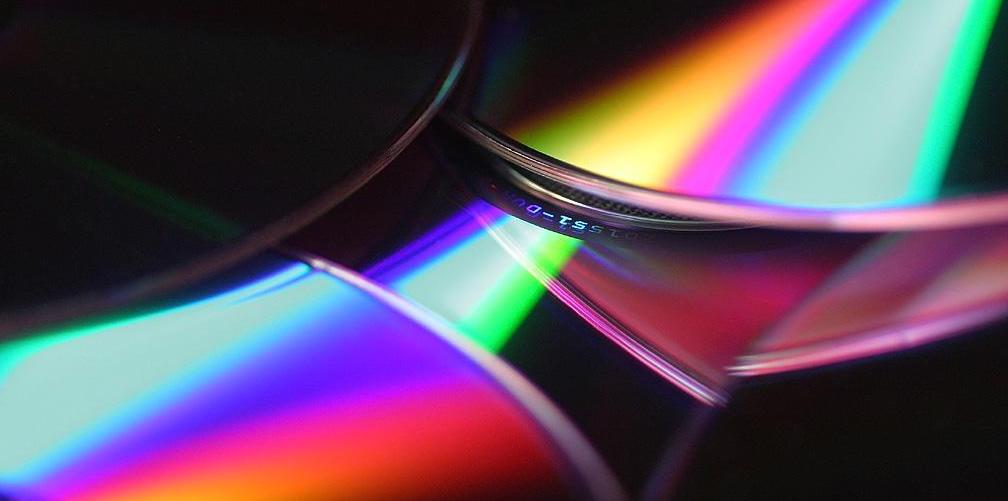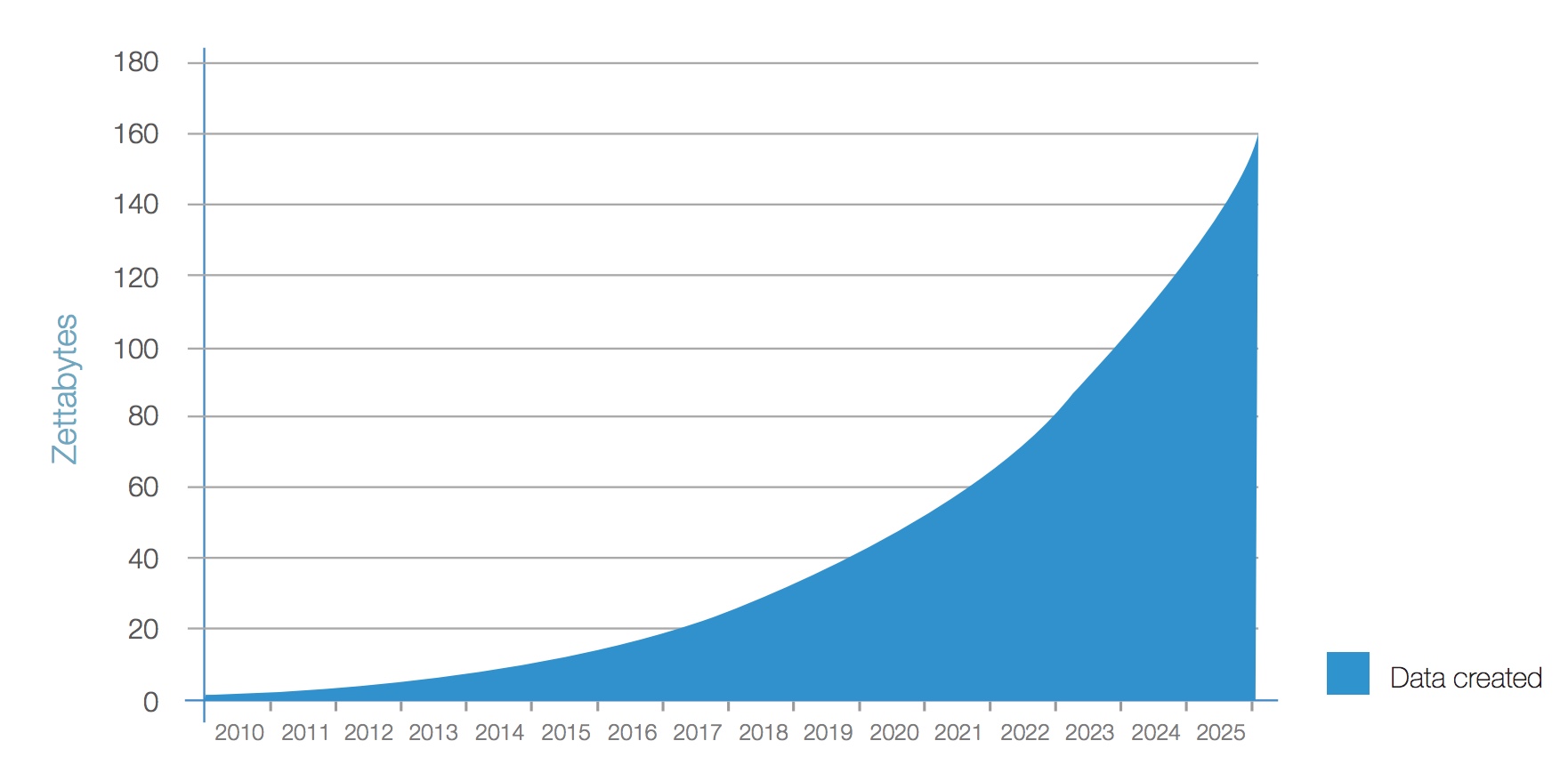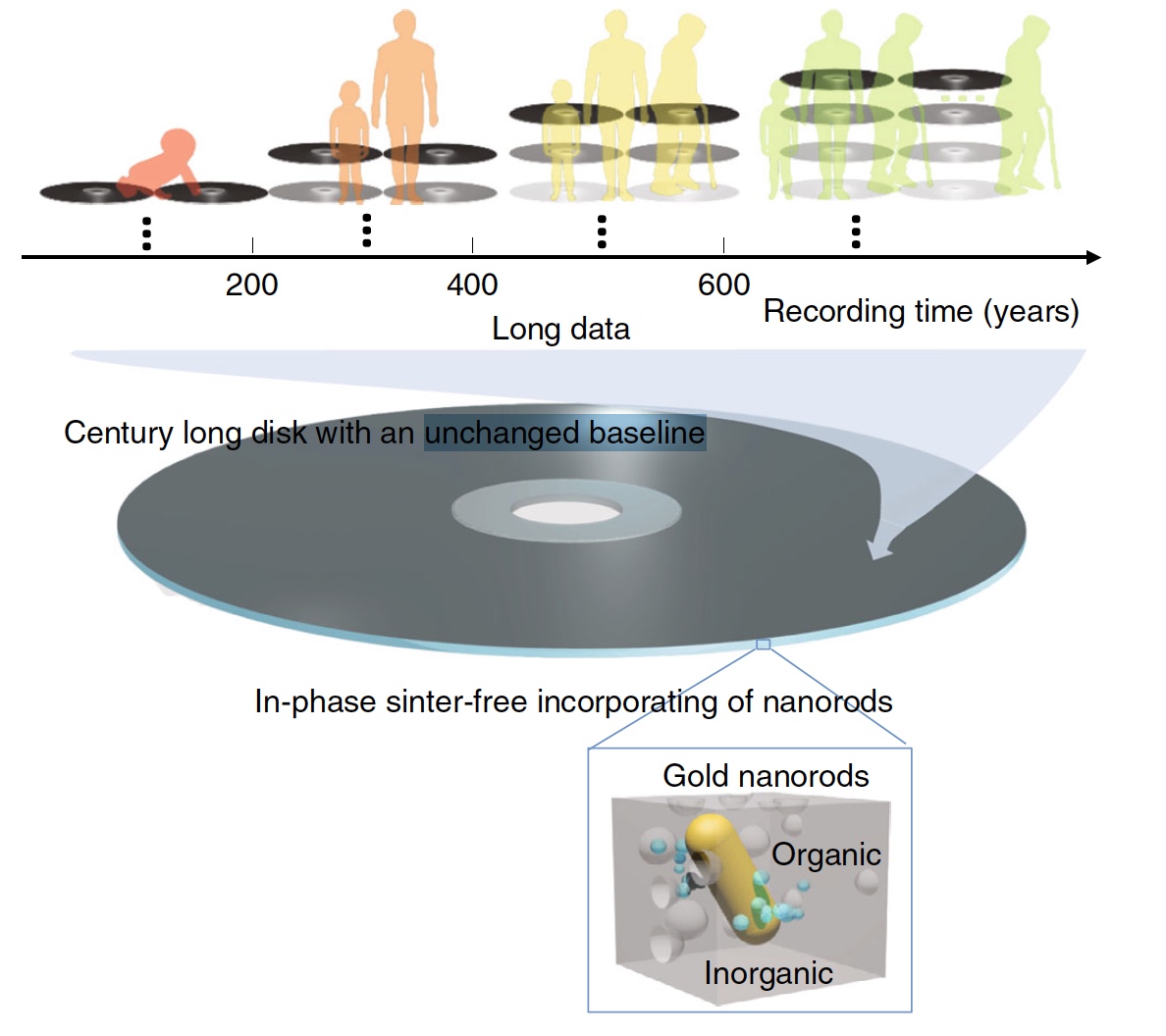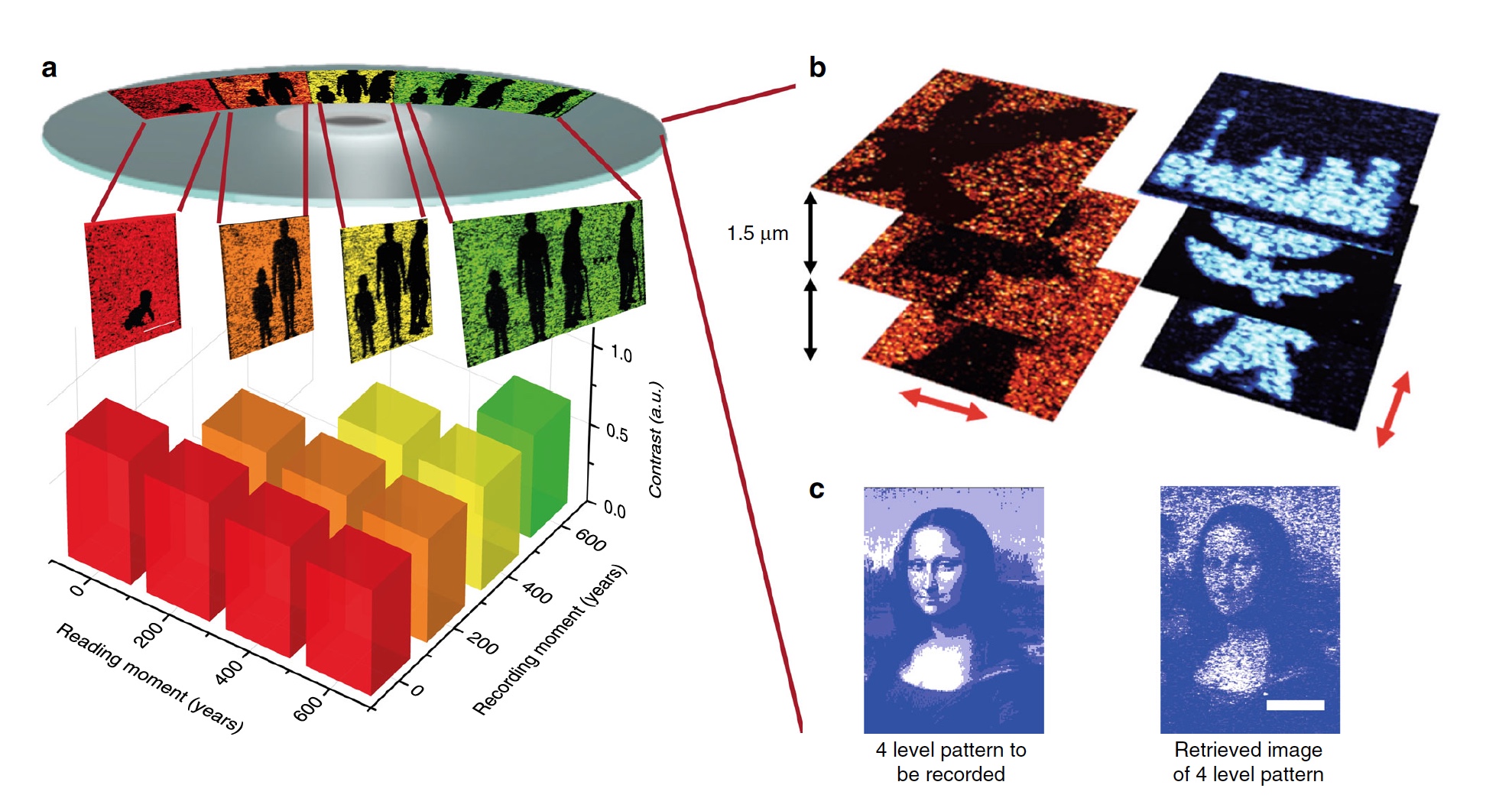Possible future of optical media: 10 TB, 600 years, one disc

What is a floppy, the younger generation may no longer know. And you should not blame them, because this type of media has long been outdated, and others have replaced it. For example, optical disks. These carriers appeared quite a long time ago, by the standards of the speed of technological development, but are still used everywhere. Going into the electronics store, we will see on the shelves drives with video games, movies, operating systems and software. However, in recent years, such a distribution as digital distribution (for example, Steam or PS Store) has been developing more and more. Simply put, we went to the “store” website, chose a product, paid for it, and then the download process went straight to the storage media embedded in your device. Optical discs come out and then begin to give way? It turns out that way. Both ordinary people and data centers are now using SSD (solid state) and HDD drives. "The future is for SSD," they say alone. But scientists from RMIT University (Melbourne Royal University of Technology) and the WIT Institute of Technology (Wuhan Institute of Technology) do not agree with these statements, they developed a 10 TB optical disk capable of storing data for 600 years. Scientists have called this technology - nano-optical memory for long data. What is this novelty, what is its feature, and whether the world needs it - we will now try to figure it out. Go.
What inspired this project?
')
The total amount of data in the world is growing every year, and it is growing exponentially. IDC analyzed the state of affairs in 2016 and expressed its vision of the future of the Earth's infosphere in 2025. The figures presented in this report are amazing.
According to IDC, the total amount of data in 2025 will be 163 ZB, which is 10 times more than the volume of sample 2016. The “Evolution” of data will be noticeable not only in quantitative, but also in qualitative indicator.

Growth in total data from 2010 to 2025, IDC co.
At the moment, the lion's share of information (approximately 60%) is generated by end users. By 2025, the main data generators will be commercial organizations, which will lead to the emergence of new tools for expanding their capabilities, as well as the need to introduce new methods for managing these data.
IDC analysts also argue that there will be growth in non-entertaining data. The percentage of data in order of importance will also change. 20% will become critically important, and 10% - above critically important.
The development of IoT (Internet of Things) will also greatly affect the Earth’s infosphere, since according to the forecast in 2025, the average person will contact devices connected to the network approximately 4,800 times a day. Data obtained from such devices will occupy 20% of the total information background of the planet.
More detailed data and analysis can be found in the IDC report itself.
Why optical discs?
First of all, in answering this question, scientists draw our attention to the fact that recently there has been an increase in attention not to "big" data, but to "long-term" ones, which make it possible to form new ideas and developments by analyzing data obtained in real time. , and collected over decades or even centuries. Long data can offer data centers more profitable (in terms of energy and financial costs) solutions.

Energy efficiency can be increased by 1000 times, since there will be less power consumed for the cooling needed for hard drives. A replacement media will be much less. Also, according to scientists, optical discs are much safer compared to hard drives.

Professor Min Gu
Here is what RMIT professor and lead researcher Min Gu says:
While optical technologies allow to increase the volume, the most advanced optical disk can serve no more than 50 years. Our technology will allow us to create an optical disk with a large volume, in comparison with the currently available optical technologies, and our tests have shown that it will work for more than half a millennium, and it can also be mass produced.At the moment, the project has a real rival - a Blu-ray disc that can work for 1000 years. However, its volume is limited to 100 GB. While the project of Min Gu is a 10 TV volume.
What is the basis of technology?
The main material for the future disc is very different from those used now - it is a golden nanoplasmic hybrid glass matrix. In order to form this matrix, a sol-gel process is required, which allows the use of precursor chemicals to create glass with a higher degree of purity and uniformity.
The main advantage of glass is its durability, up to 1000 years. However, glass has a limited internal capacity, that is, the data will live for a long time, but they will be small. Therefore, the researchers decided to combine the glass with some kind of organic or inorganic material, which eventually increased the capacity, but almost halved the service life.
Gold was chosen as an additional material because it is as strong and durable as glass.
Gold nanorods with a diameter of 10 nm were obtained using wet-chemical synthesis.
The sol-gel process at room temperature allows, without sintering, to introduce nanorods into the glass composite without changing the shape of the nanoparticles, while the shape transfer from the rod to the sphere can be used to record information. The use of inorganic materials increases the Young's modulus in the area around the nanorod, which increases the service life, as this avoids undesirable degradation of the form due to thermal exposure to the environment. For this purpose, gold nanorods were placed in a glass composite consisting of organic (polyethylene glycol) and inorganic (silicon dioxide) components. The resulting mixture was placed in an oven heated to a temperature of 313 K = 39.85 C for 1 week. This temperature is much lower than the melting point of gold nanorods.

The image (a) shows that the surface of the gold nanorod is completely and without breaks covered by a hybrid glass composite.
The image (b) shows the Young's moduli with different proportions of organic and inorganic in the glass composite. With an increase in the inorganic component, the Young's modulus also increases due to the strong chemical bonding of silicon dioxide. The highest Young's modulus with 90% of inorganic material in the composite is 29 GPa, which is about half of the performance of silica glass (72.4 GPa).
Image (c) : An important factor in increasing the service life is the duration of the existence of a nanorod form. In order to change the shape of the new material, additional activation energy of nanorods is needed, which will allow them to overcome the elastic potential energy associated with an increase in the Young's modulus as the matrix expands. Thus, an increase in the effective activation energy will significantly increase the lifetime of the gold nanorod form, in accordance with the Arrhenius law.
After receiving the finished sample, it was necessary to check it. Several tests were conducted, among which: a test for nano-impact, a read / write data test, an aging test.
Nano Impact Test
This test was aimed at calculating the modulus of longitudinal elasticity (Young's modulus) of the material obtained in the laboratory. For this purpose, samples were used with nine points of impact, located in the form of a 3x3 matrix (distance between points 3 μm). The load force increased from 0 to 800 μN for 5 seconds. Further, the force of impact on the contrary decreased from 800 μN to 0 within 5 seconds. Also, the 800 micron force was constantly acting on the dots for 10 seconds.
Read / write
The read / write procedure was carried out using a confocal microscope with a femtosecond laser wavelength of 820 nm and a repetition frequency of 80 MHz. The laser beam was focused on the sample through an oily liquid (immersion method) with an aperture of 1.4. The data was recorded using the raster scan. The exposure time of each data point is 25 ms. The reading was carried out by detecting the fluorescent signals of gold nanoparticles using a photomultiplier tube. The basic level of the reading / writing process has remained unchanged for centuries.

(a) - comparison of fluorescent images (data) in different periods of reading / writing (service life: 0 years, 200 years, 400 years and 600). Scale: 10 microns.
(b) - Volumetric optical data memory with two polarization states in three layers located at a distance of 1.5 μm. The red arrow indicates the direction of polarization of the laser beam.
() - Four-level optical data memory card. Scale: 10 microns.
Aging
In order to simulate aging, the sample was placed in an oven at 453 K (179.85 C) for 3 hours, which corresponds to 600 years at room temperature.
All tests showed very good results, which, unfortunately, I could not find (the page with additional information regarding tests does not work at the moment).
Epilogue
The group of scientists involved in this project is more than confident in its success and in its importance.
Synthesis of a nanoplasmonic hybrid glass composite, based on a sol-gel process, compatible with the spincoating method (rotary coating), paves the way for a large-scale mass production of new optical discs. This project can become the first brick at the heart of the future of optical long data for centuries to come, which will reveal the potential for understanding long processes in astronomy, geology, biology and history. It also opens up new opportunities for highly reliable optical media that can survive extreme conditions (high temperature or high pressure).Something, and faith in your brainchild of the Min Gu team does not hold. Although the project is still at the stage of development, testing and "polishing", it has great potential. If the future super-disk (otherwise you will not call it) will have all the promised and planned properties, it can seriously organize a revolution in the sphere of information carriers. Will the new optical HDD and SSD replace? Extremely complex and controversial issue. For none of these technologies is in place and constantly gives out something new. Something able to compete with rivals. In any case, whoever became the sole “king” of the carriers, the process of research rivalry itself brought many fruits to both the world of science and technology and society. For truth is born in any dispute.
You can view the report of the research group here.
Thank you for staying with us. Do you like our articles? Want to see more interesting materials? Support us by placing an order or recommending to friends, 30% discount for Habr users on a unique analogue of the entry-level servers that we invented for you: The whole truth about VPS (KVM) E5-2650 v4 (6 Cores) 10GB DDR4 240GB SSD 1Gbps from $ 20 or how to share the server? (Options are available with RAID1 and RAID10, up to 24 cores and up to 40GB DDR4).
Dell R730xd 2 times cheaper? Only we have 2 x Intel Dodeca-Core Xeon E5-2650v4 128GB DDR4 6x480GB SSD 1Gbps 100 TV from $ 249 in the Netherlands and the USA! Read about How to build an infrastructure building. class c using servers Dell R730xd E5-2650 v4 worth 9000 euros for a penny?
Source: https://habr.com/ru/post/374389/
All Articles